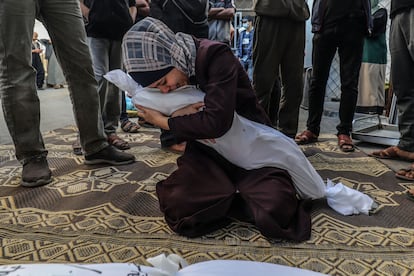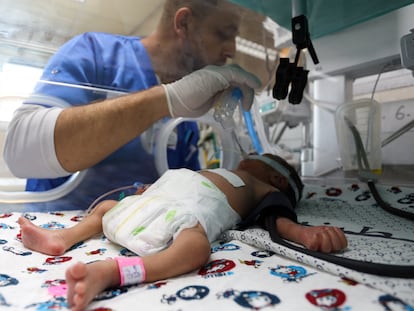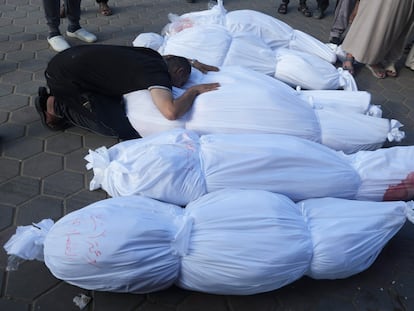Images of Gaza not to be forgotten
The presence of journalists in the territory is essential to keeping us informed of the pain and terror of a population

This coming Tuesday, it will be a month since the horrific Hamas attack on Israeli civilians. We saw how militiamen murdered young people at a music festival, the impact of rocket fire on towns on the Israeli side of the border and the assault on several kibbutz. In a brutal killing spree, Hamas took the lives of more than 1,400 people and kidnapped around 250, according to Israeli authorities.
It will also be a month since Israel unleashed its response, consisting of the heavy and relentless bombardment of Gaza’s civilian population, justifying its actions by arguing that Hamas uses civilians as a human shield and also that it has ordered the evacuation of the area. In recent weeks, Israel has killed 9,000 civilians, including 3,760 children, according to the Gazan Ministry of Health, controlled by Hamas.
We have seen terrifying scenes of corpses in the streets, people begging for help as they bleed, others buried under the rubble. But there was not a drop of blood in one of the conflict’s most harrowing images released last week in a 17-second video of a young woman clinging to the dead body of her small sister. “I doubt there is a more representative image of the inhuman pain to which Israel is subjecting the Gazan population,” a user wrote on X (formerly Twitter) about the video.
The video was taken by journalist Mahmoud Bassam. He is one of the professionals working in Gaza and every day he puts his life on the line trying to report on Israel’s offensive. He confesses that sometimes he has to stop and cry, but he feels it is his duty to keep reporting what is happening.
Several days ago, Carla Turró, deputy editor of the Catalan daily Ara, shared a video made by CNN’s Gaza correspondent, Ibrahim Dahman. In it, Dahman confesses that he never thought he would become part of the story, but here he was showing how he and his family fled from Israel’s bombs. The footage shows how the family sought refuge in a hotel where they would theoretically be safe, but had to leave three days later as the shelling encroached. “My son is terrified. I tell him, ‘don’t be afraid, son.’ But the truth is, I’m afraid too,” he tells the camera as he drives. “Seconds after leaving the hotel, they fired a rocket that heavily damaged the entire area.” The video ends with Dahman saying, “Now we are in Khan Yunis. It is only a matter of time before we flee again.”
The presence of these journalists in the Gaza Strip is essential: they are the only eyes on the ground, the only way of differentiating fact from fake news and the propaganda typical of war. They should be even more appreciated in this conflict because of the risks they are taking: so far more than 30 journalists have been killed, according to Reporters Without Borders.
“I don’t have anywhere else to go.”
— Christiane Amanpour (@amanpour) October 16, 2023
Ibrahim Dahman is a CNN journalist in Gaza and sent this first person account of what life is like right now in Gaza.
“I know deep down no building is safe.” pic.twitter.com/BbokUQCP6K
The outrage and grief triggered by the video of the mother devastated by the death of her son, the images of Gaza’s citizens broken by the loss of family members or the destruction of their homes should remain at the forefront of our collective memory and not be forgotten as soon as the next topic emerges on social media. Western leaders should heed the mass demonstrations in the streets in support of the Palestinian people and pressure Israel to stop its indiscriminate bombardment of the Gaza Strip.
Sign up for our weekly newsletter to get more English-language news coverage from EL PAÍS USA Edition
Tu suscripción se está usando en otro dispositivo
¿Quieres añadir otro usuario a tu suscripción?
Si continúas leyendo en este dispositivo, no se podrá leer en el otro.
FlechaTu suscripción se está usando en otro dispositivo y solo puedes acceder a EL PAÍS desde un dispositivo a la vez.
Si quieres compartir tu cuenta, cambia tu suscripción a la modalidad Premium, así podrás añadir otro usuario. Cada uno accederá con su propia cuenta de email, lo que os permitirá personalizar vuestra experiencia en EL PAÍS.
¿Tienes una suscripción de empresa? Accede aquí para contratar más cuentas.
En el caso de no saber quién está usando tu cuenta, te recomendamos cambiar tu contraseña aquí.
Si decides continuar compartiendo tu cuenta, este mensaje se mostrará en tu dispositivo y en el de la otra persona que está usando tu cuenta de forma indefinida, afectando a tu experiencia de lectura. Puedes consultar aquí los términos y condiciones de la suscripción digital.
More information
Archived In
Últimas noticias
Most viewed
- Reinhard Genzel, Nobel laureate in physics: ‘One-minute videos will never give you the truth’
- Oona Chaplin: ‘I told James Cameron that I was living in a treehouse and starting a permaculture project with a friend’
- Pablo Escobar’s hippos: A serious environmental problem, 40 years on
- Why we lost the habit of sleeping in two segments and how that changed our sense of time
- Chevy Chase, the beloved comedian who was a monster off camera: ‘Not everyone hated him, just the people who’ve worked with him’











































